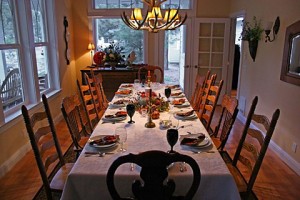 This Thanksgiving millions of Americans will sit down at the dinner table with their friends, loved-ones, and on some occasions, people they barely know or only pretend to like. They will eat, drink and sporadically run to the living room to get updates on the score of the Packers-Lions game.
This Thanksgiving millions of Americans will sit down at the dinner table with their friends, loved-ones, and on some occasions, people they barely know or only pretend to like. They will eat, drink and sporadically run to the living room to get updates on the score of the Packers-Lions game.
And, if the world’s most eminent scholar of dining decorum, Miss Manners, gets her way, they will conform to the basic rules of table etiquette and remember to always set the table with the knife facing in. Rather than poorly paraphrase her witty comment, which provides information on everything from eating etiquette to historical stabbings, I’ve included it with the question below.
DEAR MISS MANNERS: In setting the table for the Thanksgiving repast, there is some debate about which way the knife should face. One of the family recalled that in time of war, the blade faces outward; in time of peace, it faces inward. Another opinion suggested that it always is toward the plate. Your guidance please, sage lady?
GENTLE READER: It is always good to be prepared, and in case of attack you wouldn’t want to have to take the time to turn your knife around.
However, at the Thanksgiving table, any attack is likely to come from one of your relatives. And we want to discourage patricide (even of fathers whose carving destroys the turkey and who keep the drumsticks for themselves), infanticide (even of babies who have been crying steadily for half an hour), and aunticide (even for those whose idea of conversation is, “Isn’t it about time you got married?” and, “I see you’ve put on some weight”).Mealtime stabbings are considered bad form, even at Thanksgiving. In 1669, Louis XIV of France decreed that knives must be rounded at top, not threateningly pointed. (Oh, wait, that was to stop people from using their knives to pick their teeth.)
The rule is that regardless of what else is going on in the world, the table is set with knife blades facing in.





Leave a Reply